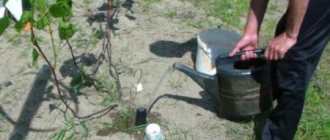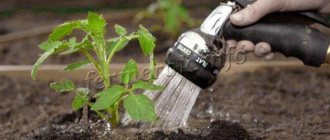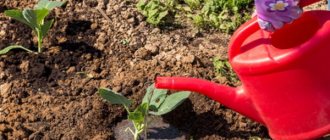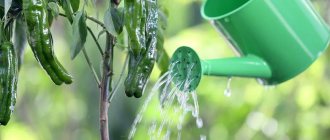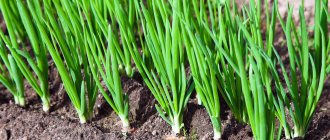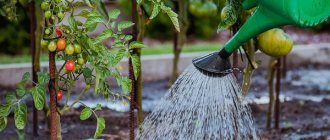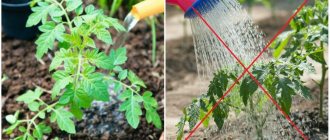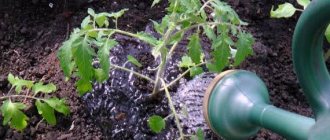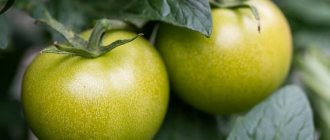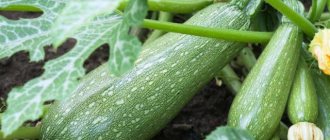Watering onions in open ground is one of the main agrotechnical procedures that ensure active growth and high yields of any vegetable crop. When growing onions, special attention must be paid to watering, because the vegetable needs moisture for development, but its excess leads to fungal diseases. Therefore, to obtain a generous and high-quality onion harvest, you need to follow the basic subtleties of agricultural technology.
Rules and regulations for watering onions
Once planted, onion heads take about 60 days to form and grow. During the growing season, the soil in the garden bed should always be moist.
During rains, watering is not carried out, but in hot weather the soil should be moistened 1-2 times a week.
For 1 sq. m of bed with onions requires 10 liters of water.
You should not over-moisten them; otherwise, pathogenic organisms may appear in them, and after harvesting the fruits will not be stored for long.
Water the onions in the early morning or evening so that the sun does not cause the feathers to burn through droplets of water.
Fertilize the plantings once a week during watering. The culture loves nitrogen, phosphorus and potassium.
During fertilization, onions are watered before and after adding preparations to the soil so as not to burn the root system of the crop and evenly distribute nutrients in the soil.
Basic rules for watering in open ground
It is recommended to moisten the beds in the morning or evening. Because plants can get burned if drops of water get on the leaves on a hot sunny day.
It is necessary to put a watering can-type clamp on the hose. Otherwise, it is easy to wash away the surface fertile soil and onion heads with strong water pressure. It is also not recommended to throw water out of the bucket, otherwise the seedlings will be washed out and will not be able to take root.
Properly water the crop with warm water - this stimulates the growth of root crops and reduces the likelihood of the appearance of fungi and bacteria. The water is not specially heated. It is enough to install a water tank in a well-lit place connected to the irrigation system. Acceptable water temperature is 15-17°C. The barrel is filled with water and after a day and a half you can start watering the beds.
If the garden or cottage is located in a low-lying/damp place, then create high beds for onions. When forming a ridge, the bottom layer must be made drainage (expanded clay, brick chips, small pebbles or crushed stone are used).
Watering methods
- Drip - the irrigation system is turned on at night.
- The hose makes work easier and moistens the soil well with medium water pressure.
- Watering can - used for watering young seedlings from above from a shower head. After the turnip has formed, water is poured from the spout into the rows.
- Ladle or jar. 1 liter of water is enough for 5 bulbs. Water is poured so as to moisten the roots of the plant.
After watering, the soil must be loosened to improve oxygen access to the root system, thereby ensuring rapid growth of greenery.
Important! Do not throw water onto the onion bed. The bow is 2/3 buried in the ground. When the water splashes out, it will wash the seedling out of the soil and it will be difficult for it to take root.
Features of sprinkler irrigation systems
Sprinkler irrigation is effective when caring for lawns, in greenhouses and large areas of agricultural crops.
The installation itself is a system of pipes with nozzles spraying water - sprinklers. The sprinkler effect is created using dividers in the nozzles. This device has a more beneficial effect on plants even compared to drip irrigation.
Features of sprinkler humidification:
- optimal frequency and rate of watering in any weather;
- there is no risk of soil erosion or formation of soil crust;
- not only the root system is moistened, but also the ground layer of air;
- moisture and fertilizing mixtures are distributed evenly;
- the soil temperature decreases, which prevents it from drying out.
The cost of sprinkler irrigation is high, but in the southern regions of our country its use is economically beneficial.
When and how to water onions: norms and frequency of watering
Before boarding
To prevent onion fly infection, the beds can be shed with an aqueous solution of birch tar before planting. It is prepared in the following proportion: dilute 1 tbsp in a bucket of water. fly in the ointment. Carrying out such a procedure will repel harmful insects for some time. If signs of infection are subsequently detected again, it will be possible to water the beds with this solution again.
Watch the video! Watering the beds before planting onions
Period of entry appearance and active growth
Abundant watering is required during active growth and filling of turnips.
- For 1 sq. meter of plantings spend 10-12 liters of water.
- In dry weather, watering is carried out once every 5-6 days.
- Water is poured into the furrows or between the rows.
- Some gardeners install drip irrigation systems.
- In rainy weather, watering is not carried out.
After the emergence of seedlings, during the first 3-4 weeks, pour enough water to moisten the soil to a depth of 10-12 cm. Next, moisten the soil to a depth of 20-25 cm.
to determine whether the onions need to be watered, you can dig a hole 7-10 cm deep between the rows and take a handful of soil at the bottom and press it down lightly. If the soil crumbles, watering is needed. If it stays lumpy, the soil is still wet.
When watering, you can add Energen, a growth and development stimulator of onions, to the water, which also reduces the nitrate content in fruits and increases yield by 40%. 1 capsule of the product is diluted in a bucket of water.
Watch the video! Proper watering of onions
Features of watering onions grown by feathers
When growing onions on a feather, the plantings are watered more often than when planting on a turnip.
In warm and dry weather, water 2-3 times a week with 8 liters of water per 1 square meter. meter of plot.
Advice! When watering at the root, the feather will be longer.
Onions are watered almost before harvesting begins. 5 days before trimming, the soil is no longer moistened so that the feather is not watery and brittle and can be stored longer.
When to stop watering
60 days after planting, onions stop growing and begin to accumulate nutrients and sucrose. At this time there is no need to water it. From mid-July, the feathers go down, the upper scales of the turnip turn yellow and dry. After this, the fruits are ready for harvest.
For a long time, the feast of Peter and Paul, July 12, is considered the date when they stop watering onions when growing turnips.
What water to use
You can water onions in spring and summer only with pre-settled water. To do this, water is poured into large containers and left at room temperature or outside for at least 12 hours. If possible, you can use filtered liquid for irrigation in open ground.
Melt or rain water is even better. Thaw is stored in advance in winter. To accumulate rainwater, it is enough to leave several large open containers outside. After settling, the water should reach room temperature (from +15) or become a little warmer - up to 20-22 degrees.
But it also happens that there is no time to wait. Then you can water green onions in open ground with unsettled water. Take ordinary liquid from the water supply and add boiling water (1:10), stir. As soon as the temperature is in the range of 15-22 degrees, you can start watering.
How and why to water onions with salt water
Plantings are watered with a salty solution to combat the onion fly, the main pest of onions, which lays larvae in the ground, and small worms eat the fruit. The pest also destroys the feather. The plant dries out.
Salt water also helps control other pests. The procedure is carried out in 3 stages:
- Stage 1 - when the feather has grown by 5-7 cm, the solution is prepared with the following concentration (1 liter of water and 30 g of salt).
- Stage 2 - 10 days after the first watering (1 liter of water and 40 g of salt).
- Stage 3 - 10 days after the second treatment (1 liter of water and 60 g of salt).
With a small lesion, you can use a weak dosage each time - 30 g of salt per 1 liter. After each procedure, the onions are watered with clean, settled water.
Water requirements
In order to bring maximum benefit to the plant, the best solution is to take slightly warm, settled water . If you water onions with cold water or from the tap, then due to the sharp temperature contrast, they will always experience stress - this is the reason for poor crop growth.
It is important that the water settles to room temperature (no less than 14-18 degrees Celsius) in advance (in the evening, if a person is going to water in the morning, or, conversely, when the sun rises for evening watering). For this purpose, it is necessary to fill some container with water (for example, a jar, barrel, bathtub, etc.) and leave it for some time.
Very warm or, even worse, hot water will also not do any good. Due to the increased temperature and humidity, excellent conditions are created for the development of rot on plants.
However, watering with water slightly above room temperature is needed in those few months when active growth of green shoots and bulb formation occurs. After this period, the heads do not grow, and they begin to accumulate useful substances.
Watering with fertilizing
In addition to organic and mineral fertilizers, there are other types of fertilizers.
Ammonia solution - 3 tbsp. spoons are diluted in 1 bucket of water. The solution is applied at the root in the evening. It saturates the soil with nitrogen and repels the onion fly.
Watch the video!
A super remedy - ammonia against onion flies. Caring for onions is not difficult. The main thing is to adhere to the rules of watering, which plays an important role in the formation of turnips and feathers, and also affects the further storage of the harvested crop.
When is irrigation not required?
The watering schedule depends entirely on the climatic characteristics of the region. In areas with arid climates, the process of irrigating beds takes longer.
Expert opinion
Stanislav Pavlovich
Gardener with 17 years of experience and our expert
Ask a Question
Important! On rainy, cool days, watering is stopped completely.
When planting sets in winter, it is assumed that the onions should not grow until spring. Therefore, bulbs are planted in dry, cold soil. Of course, it will not be possible to avoid soil moisture in the event of rain, but special watering is not carried out.
Soil preparation
Chernozems, loamy and sandy loam soils are suitable for planting onion plants.
On clay soil, seeds may not sprout at all. The reason for this is the hard crust that forms on the surface after precipitation or watering. To exclude this option, prepare the soil in advance by adding rotted compost or growing green manure.
Soil acidity should be between 6 and 6.5 units. If it is higher, liming is necessary.
Fresh manure is not applied when planting onions. Bird droppings are soaked in water for 3 to 5 days. During this time, ammonia, which is toxic to plants, will evaporate from it.
Soil preparation is carried out in autumn and spring.
After harvesting, organic residues are removed from the beds. They dig up the soil deeply, point-blank. The layer of earth is turned over, but the ground is not leveled. It is advisable to immediately add rotted organic matter; over the winter it will partially decompose and the beneficial substances will be absorbed into the soil.
In spring, the soil is dug up again and loosened well. Large lumps of earth will not allow the seeds to sprout together. Loosening will reduce the evaporation of moisture necessary for germination. The contact area between soil and seeds will increase, which will prevent them from drying out.
Answers to frequently asked questions
How can you speed up the ripening of onions in a rainy summer?
It often happens that the onion harvest time is approaching, but the feather has not yet died completely, the colored husk has not formed. And the gardeners stopped watering a long time ago.
In this case, some folk methods come to the rescue.
For example, you can partially rake away the soil from a turnip about a week before harvesting.
There is also a method of undermining the roots of a turnip. This is done using an ordinary garden fork, which gently lifts the turnips.
It is possible to undermine the roots with a sharp shovel, going five or six centimeters below the bottom of the onion. All these techniques are aimed at limiting the supply of nutrition to the vegetable and speeding up its ripening.
Planting onions before winter
Autumn planting gets an early harvest by the beginning of July.
For planting before winter, select the smallest available heads. They are unlikely to last until spring. If stored for a long time, the onions will simply dry out.
Before winter, seedlings are planted a little earlier than nigella. We need to do this before frost sets in. Select days when the night temperature begins to drop to 2 - 3 C.
Preparation of planting material occurs according to the previously described method: selection, treatment with antifungal and stimulating drugs.
Seed preparation
Regardless of whether the seeds are sown to obtain seedlings or directly into the ground, several agrotechnical measures need to be carried out:
Quality checking. The need for this operation is caused by poor germination of seeds; if it is insufficient, to obtain even germination during sowing it is necessary to increase the planting density.
To check, the seeds are wrapped in a damp cloth and left for a period of 10 to 20 days, periodically moistening. There are no special temperature conditions for this - onion seeds germinate at temperatures from +2 degrees Celsius. If less than 75% of the seeds have germinated, increase the planting rate;
Spores of fungal diseases are destroyed by soaking the seeds in a pink solution of potassium permanganate. Treating time is 10 - 12 hours immediately before sowing;
Before planting, the seeds are dried - when wet, it is difficult to distribute them evenly over the surface.
Common mistakes
Often those who like to grow onions themselves, when determining the timing of harvesting, are guided by the ripening time indicated on the packages of seed. Having mathematically calculated the harvesting period, they continue to water, not paying attention to obvious signs of readiness.
Favorable weather conditions and a moderately dry summer will allow you to start digging turnips after the mathematically calculated deadlines have passed. And an excessively hot summer and lack of precipitation will force turnips to reach technical maturity earlier. In this case, you should stop watering contrary to the recommendations indicated on the packages.
Rainy and cool weather will cause the vegetable to ripen significantly longer. Uncomfortable weather can also cause uneven ripening.
Then you should harvest only those fruits that are guaranteed to be ready for storage. The feathers on such turnips have completely turned yellow, the neck has become soft and no longer holds the stem. When you test pull it out, the husk should easily separate and rustle. Turnips that have not reached these signs should be left in dry soil to ripen.
